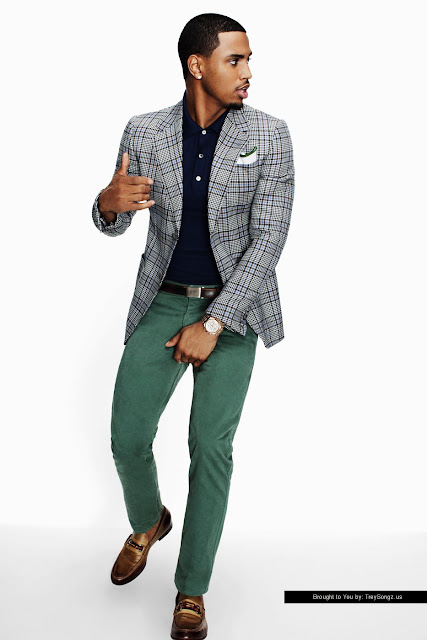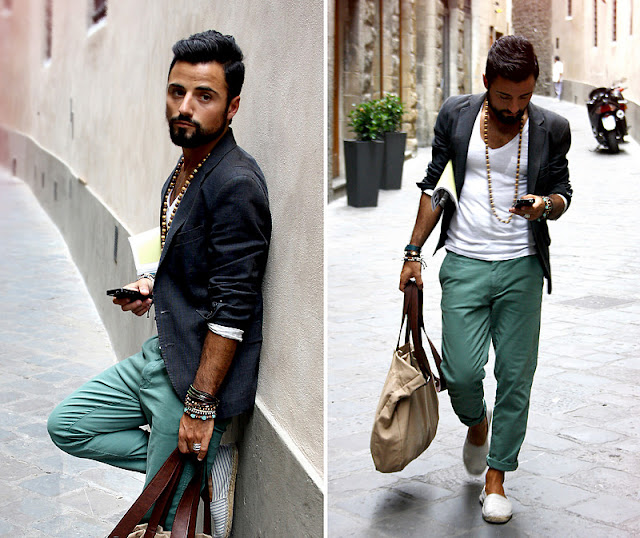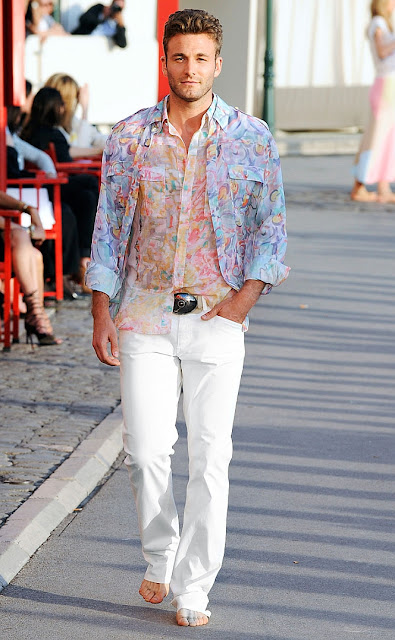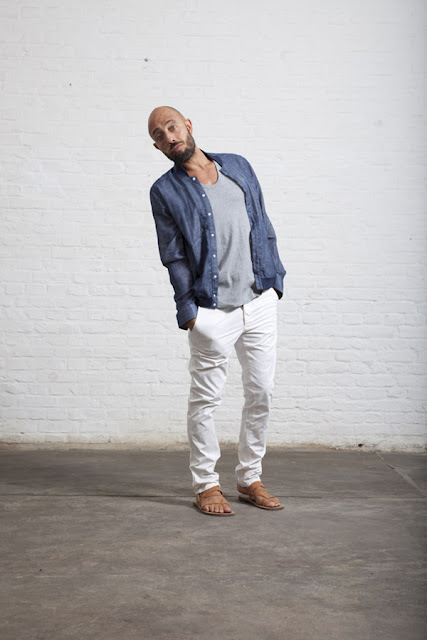The word blazer is one of the most incorrectly applied
terms in men’s fashion. It is typically used as a general reference to describe
almost any suit-type jacket, but a man's “blazer” has a more specific meaning.
Both a blazer and a sport coat are casual jackets that are worn on their own
rather than as a part of a complete suit. Although used interchangeably, the
difference between the two has more to do with their fabrication and styling. A
sport coat is traditionally made with an earthy fabric like tweed or
houndstooth with three buttons, flap pockets and sometimes an extra ticket
pocket on one side. As the name suggests, a sport coat was once meant to assist
in the untimely demise of cute, harmless animals like deer or rabbit in the
English countryside. Men's blazers, on the other hand, are made of a sturdier
fabric than a suit, yet smoother fabric than a sport jacket. It is usually
thought of as single-breasted, but it can also come in a double-breasted ahoy
matey version. Blazers also have patch pockets as opposed to flaps, and in the
single-breasted variety, it comes with two metallic buttons for closure.
To avoid confusing the two styles any further, learn more
about the differences between a jacket and a blazer; this way, you’ll avert any
unbecoming fashion blunders, like showing up to your formal business meeting in
a heavily patterned sport jacket and flannel trousers.
Sport Jacket.
The sport jacket derives from the experimentation with
sports clothes in the mid-nineteenth century. By the early twentieth century,
men were seeking comfort and high fashion in their clothing, and turned to the
ever-evolving sport jacket as a fashion-forward, casual answer to laidback
social functions -- meaning, an afternoon at a stuffy gentleman’s club or while
sitting on the sidelines of a tennis match.
Today’s sport jacket, however, has a very different
meaning as it can also be dressed down with a pair of jeans or chinos for more
casual functions.
The patterned sport jacket appeared after World War II to
accommodate the business-casual lifestyle that men began leading. Incorporating
bold patterns like Shetland stripes (seen on Ivy League campuses) and madras
plaids (seen in colleges and country clubs), patterned sport jackets were a way
for the fashion-conscious, modern man to avoid having his jacket embarrassingly
mistaken for a suit jacket.
As always, there are a few things you need to consider
when purchasing this particular style of jacket:
- Fit is King – as always, make sure it fits your properly! You want it hug your shoulders and follow the lines of your body all the way down to your waist. A good sports jacket should make you stand up straight and hold yourself differently. Most guys wear a size too big so always try the size down. You shouldn’t be able to throw a ball overarm in a properly fitting suit!
- What’s the plan? Think about what you’re buying this jacket for. Do you want it to serve multiple purposes at different events? Then stick to a neutral colour in a subtle stripe or check. If you have a particular event or setting in mind then there should be more room to get creative. Maybe something in pink or mint green in a bold stripe will do? Either way, planning is everything.
- Compliment, don’t match – You should think about what you will be wearing with the jacket as much as the jacket itself. Always try to compliment the jacket rather than wearing something in the same colour family. For example, if the jacket is in navy why not try burgundy or olive chinos? Or if you’re feeling really bold maybe something in yellow? If the jacket is in a less neutral colour such as red, stick to muted complimenting colours such as blues and greens.
The sports jacket is the most important item in your
wardrobe this season in my opinion. Regardless of your personal style or take
on fashion, I think every guy can benefit from at least one sports jacket. For
guys who prefer casual comfort, it’s an easy way to dress up a look without
feeling too formal and stuffy in a suit. The same goes for the suit and tie men
out there, it’s the perfect weekend addition that allows your look be more
relaxed and playful without reaching straight for the unstructured blazer.
There are countless ways to style it, whether you've got
business to handle or you're simply hanging out. Just remember: It's called a
sports jacket for a reason. You can dress it up, but it's meant to be played
in. Hard. That means throwing it on the backseat of your car or cramming it in
your backpack once you've peeled it off. It doesn't need an occasion, and it
doesn't need to match anything. It just needs to be worn...and worn...and worn,
until it fits you like a second skin.
If you’re looking to add some sport jacket to your
wardrobe, this selection of sport jackets is the way to go. It’s perfect for
pairing with denim or shorts for a refined casual look.
 |
| HERNO |
 |
| ALICE SAN DIEGO |
 |
| DOLCE &GABBANA |
 |
| PATRIZIA PEPE |
 |
| MAURO GRIFONI |
 |
| KENZO |
 |
| LOVE MOSCHINO |
 |
| DSQUARED2 |
Blazer.
By 1938, blazers were the fashionable odd jacket of
choice for style connoisseurs. Originally a part of the English cricket club
scene, the blazer was often striped and in club colors. This look eventually
evolved to include brass buttons, single and double-breasted models, and a club
badge on the breast pocket. Blazers are offered in a variety of styles with
different detail options, including flap or patch pockets and peak or notch
lapels. Depending on your blazer style of choice and what you pair it with,
blazers are easier to dress down than sport jackets.
Navy-colored blazers adorned with brass buttons were
predominant throughout the 1920s, and made a stylish sports outfit when paired
with white pants. And due to their lightweight fabric, these nautical-inspired
blazers were summer fashion sensations.
Thanks to the British wave of fashion sweeping our North
American streets, the traditional nautical blazer may still look trendy in the
late spring or early summer.
Blazers rightfully got their name because they were
“blazed” with more color and bolder patterns than the refined sport jacket.
Blazers weren’t only striped, but they also came in a variety of bright colors,
like powder blue and purple, and started making their way into men’s
weekend-wear wardrobes.
The bold patterns and heavy tweed fabric of the sport
jacket make it inappropriate for business or formal wear. Pair it with denim or
corduroy for more casual outings. If you’re going to wear a blazer, keep the
breast pocket bare; don’t adorn it with a badge unless you wear your blazer for
club purposes.
Nowadays, traditional double-breasted, brass-buttoned
nautical blazers are usually worn by older men (we’re talking the grandpa
generation here). In other words: Don’t do it. Single-breasted blazers, whether
navy or colored without the brass buttons, are modern and versatile as they can
be dressed up with flannel trousers or dressed down with denim. And they can be
accessorized with the most formal of ascots or the most basic of ties.
Your only choice when attending a formal event, such as a
business meeting or a wedding, is to disregard both the jacket and the blazer
and wear a suit.
Although often confused, the sport jacket and the blazer
are two very different items of clothing. They each have their respective
places in history, and each has its own distinctive method of being worn. So
while they might both be jacket-like, sport jackets and blazers certainly aren’t
cut from the same cloth.

































+PEOPLE.jpg)







